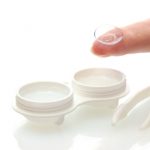Keratoconus
Medically Reviewed by: Brian S. Boxer Wachler, MD

Keratoconus (also referred to as KC) is a progressive eye disorder characterized bulging of the cornea, which is the clear, dome-shaped outermost layer of the eye. The condition affects roughly one out of every 2,000 people, according to the National Keratoconus Foundation (NKCF).
The cornea plays an integral role in focusing and provides structural support, helping the eye maintain its uniform, curved shape. Keratoconus weakens the structure of the cornea, causing it to bulge out in a cone-like shape, in turn leading to distorted vision in the form of irregular astigmatism and nearsightedness. (The name of the condition is derived from the Greek Kerato, meaning cornea, and Conus, meaning cone.)
Keratoconus typically affects both eyes and is most prevalent in teenagers and young adults in their 20s. Untreated, the condition can worsen over the course of a 10- to 20-year progression, after which it typically stabilizes.
Symptoms of Keratoconus
In addition to bulging of the cornea, there are a number of symptoms indicative of keratoconus, including:
- Blurred vision
- Astigmatism
- Double vision
- Light sensitivity
- Nearsightedness
- Loss of visual acuity
Keratoconus can be easily diagnosed during an eye exam using a slit lamp and/or corneal topography.
What Causes Keratoconus?
Keratoconus is caused by thinning of the cornea, but there is no definitive underlying cause. Research suggests that an enzyme imbalance in the cornea could make it more susceptible to free radicals and weakening. Other studies have suggested a link with certain allergic conditions, excessive rubbing of the eyes, overexposure to sunlight and chronic eye irritation. Further, there appears to be a genetic connection.
If you have a history of keratoconus in your family, you are at greater risk of developing the disorder and should be evaluated with regular eye exams starting at age 10.
Treatments for Keratoconus
Although keratoconus doesn’t cause blindness, it can lead to severe visual impairment. Fortunately there are a number of treatment options, some of which include:
Corneal Cross-linking (CXL) – Stops the progression of keratoconus by strengthening collagen bonds in a layer of the cornea called the stroma. The simple, non-invasive CXL procedure involves applying riboflavin (B12) drops to the eyes and projecting ultraviolet light onto the cornea. This helps to develop new, stronger collagen bonds. In late 2016 Avedro became the first company in the U.S. to get FDA approval for its CXL procedures and products.
Contact Lenses – Mild nearsightedness and astigmatism associated with early stage keratoconus can be corrected with custom soft contact lenses like Bausch + Lomb’s KeraSoft lens and Alden Optical’s NovaKone lens. However, as the condition worsens, a gas permeable (GP) contact lens may be needed. GP lenses are harder than the custom soft variety, helping to correct the abnormal bulging of the cornea and improve vision. Some people may find GP lenses uncomfortable and seek an alternative keratoconus treatment solution.
Corneal Rings – Also called corneal ring segments or intrastromal corneal ring segments (ICRS), corneal rings are tiny, plastic implantable devices that reshape the cornea to eliminate the bulging associated with keratoconus. The safe, simple and reversible procedure takes approximately 15 minutes per eye, and more than half of patients achieve 20/20 vision or better.
Corneal Transplant – If all else fails, the last option is corneal transplant surgery, where the bulging corneal tissue is removed and replaced with donor tissue. Also called penetrating keratoplasty (PKP), this invasive treatment option is relatively rare, with less than 20 percent of patients opting for transplant.
Schedule a Consultation
If you are experiencing keratoconus symptoms or have a history of the eye disorder in your family, schedule a consultation with an ophthalmologist to undergo a simple eye exam. The earlier you are able to diagnose keratoconus, the more options you have in terms of treatment.
About the Reviewer

Brian S. Boxer Wachler, MD, is a Board-certified ophthalmologist and multi-published book author in private practice in Beverly Hills, CA. Often referred to as “America’s TV Eye Doctor,” Dr. Boxer Wachler has a stellar reputation for excellence amongst his peers who have elected him as one of the “World’s Best Refractive Surgeons.”
Dr. Boxer Wachler (or Dr. Brian as his patients affectionately call him) has devoted his career to vision correction, with expertise spanning an array of conditions and treatments, including cataract surgery, FortifiedLASIK™, the treatment of keratoconus and more. To learn more about Dr. Brian, visit his keratoconus specialty website at https://keratoconusinserts.com/.




